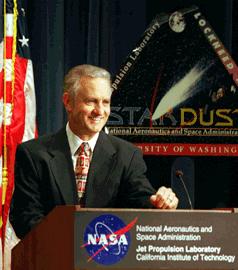STARDUST Status Report
March 12, 1999

Ken
Atkins
STARDUST Project Manager
STARDUST was successfully placed into its Cruise 2 configuration last
Sunday March 7 where the spacecraft turns to point the medium
gain antenna to Earth for communications at a higher data rate than the low
gain antenna used when the spacecraft was much closer to Earth. Also,
testing of the star camera was started late Monday in preparation to use it
in a "tracking" mode to relieve control of the spacecraft attitude by the
gyro inertial measurement unit (IMU). Moving to "all stellar" control will
preserve operating life on the IMU for the encounter and other
gyro-required operations. After an hour of successful testing, as the
tracking mode was introduced, a star camera data-read error occurred
causing the spacecraft to automatically move to its previous "safe" mode
(Cruise 1 configuration), switching back to the low gain antenna and
minimizing operations until it received new commands from controllers on
Earth.
The flight operations team moved back to communications with the spacecraft
over the low gain antenna and verified that the spacecraft was in its expected
state and in excellent health. Late Tuesday March 8, the data history on
the testing was "downlinked" to mission controllers so that a detailed trace
could be done on what caused the data error and subsequent automatic action by
the spacecraft's fault protection system. Detailed analysis of the data and
track mode software sequence is underway to understand the suspect operation
and correct it.
Wednesday and Thursday, STARDUST was again moved to Cruise Phase 2
configuration that places the spacecraft on the medium gain antenna during
communication passes over the Deep Space Networks's (DSN) ground antennas.
At the higher data rate, data from the Dust Flux Monitor (DFM),
Cometary and
Interstellar Dust Analyzer (CIDA), and the image taken by the star camera
during the track-mode test operations were brought down. These had been
"backlogged" on board during the low data rate Cruise 1 Phase. The star
camera engineering test image (first image from STARDUST) shows Mars very
bright against the star background as seen from STARDUST's view. The image
will be posted on the STARDUST web site (http://www.STARDUST.jpl.nasa.gov)
